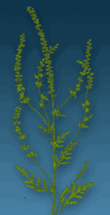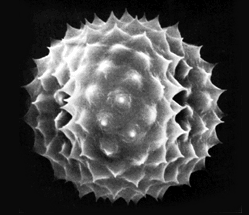Click on the name of a different pollen below to find out more about
it,
or click on the other microscope for a different view of this pollen.
| Plant: | Pollen: | Microscope: |
 |
 |
|
|
Ragweed Sometimes called hay fever weed, ragweed causes more allergies than all other plants put together. A single ragweed plant can send billions of invisible pollen into the air, and many of them will land in your unsuspecting nose. In the United States, ragweed pollen causes hay fever in over 25 million people. The pollen flower of ragweed is so tiny it's hard to see one. What you can see is a cluster of hundreds of flowers. They grow at the top of the plant and at the ends of side branches. You can tell when the flowers are shedding their pollen because the lower leaves of the plant will be covered with yellow dust. Hay fever is the common term for ragweed allergy even though the allergy isn't caused by hay, and it doesn't give you a fever. The misnomer dates back to an English scientist in 1829. He noticed that the allergy happened around haying time, and so he called it hay fever. The symptoms of hay fever are itchy eyes, sneezing attacks, a clogged or runny nose, sinus headaches, and blocked ears. Note: You may have unfairly blamed goldenrod (Solidago) for your late summer hay fever. But goldenrod pollen is spread mostly by insects, not by the wind, so you're not likely to breathe it in. The sticky, heavy pollen travels when insects land on the flowers and carry the pollen away on their body. Unless you actually bury your nose in the flowers, goldenrod won't give you hay fever. |